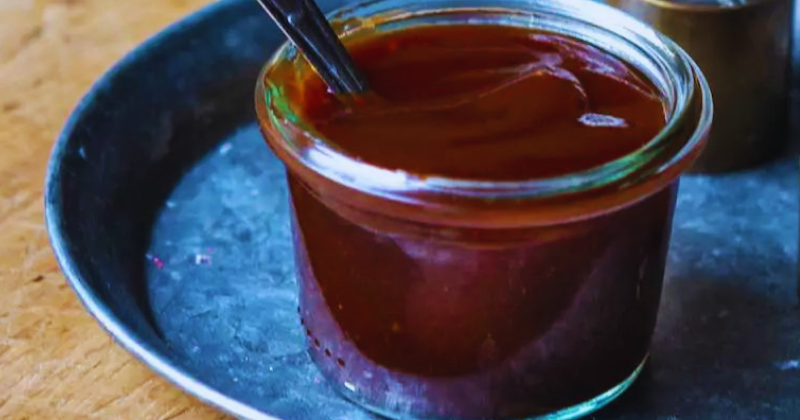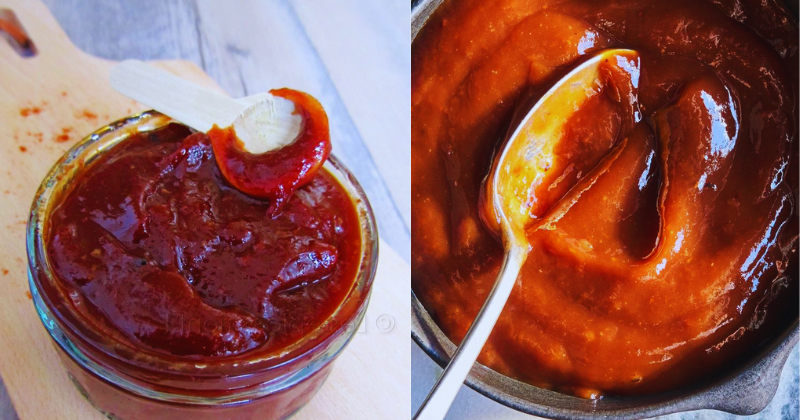Prep Time: 5 minutes | Cook Time: 25 minutes | Total Time: 30 minutes | Yields: 2½ cups | Difficulty: Beginner
Table of Contents
Why You’ll Love This Easy BBQ Sauce Recipe
This easy homemade BBQ sauce will completely change how you approach backyard grilling and weeknight dinners. Most importantly, it’s incredibly cost-effective—you can make nearly three cups of premium-quality sauce for less than the cost of a single bottle of gourmet store-bought varieties, and the flavor is infinitely better because you control every single ingredient.
The family-friendly nature of this recipe means it appeals to everyone from picky toddlers to sophisticated adult palates. The balanced sweetness comes from real brown sugar and molasses rather than high-fructose corn syrup, while the tangy vinegar backbone provides brightness without overwhelming heat. Even spice-sensitive family members will love this approachable flavor profile.
What truly sets this recipe apart is its remarkable versatility and customization potential. This base recipe serves as your foundation for creating countless variations—add chipotle for smokiness, increase vinegar for Carolina-style tang, or boost the brown sugar for Kansas City sweetness. It’s like having a master sauce recipe that adapts to any regional preference or personal taste.
The make-ahead convenience factor cannot be overstated. This sauce actually improves with time as flavors meld and deepen, meaning you can prepare it days in advance for stress-free entertaining. Plus, it keeps beautifully in the refrigerator for weeks, giving you an instant upgrade for any grilled protein or leftover transformation.
Essential Ingredient Insights & Smart Selection Tips
Creating exceptional BBQ sauce begins with understanding how each ingredient contributes to the final flavor symphony. Ketchup forms your base, so choose a brand you genuinely enjoy—Heinz and Hunt’s both work beautifully, providing the tomatoey foundation and natural sweetness that anchors everything else. Avoid generic brands with artificial flavors that can create off-tastes.
Brown sugar does more than sweeten; it adds molasses complexity and helps create that gorgeous caramelized glaze when your sauce hits hot grilled meat. Apple cider vinegar provides the crucial acidic brightness that cuts through rich, fatty foods and balances the sugar’s sweetness. White vinegar works in emergencies, but apple cider vinegar contributes subtle fruity notes that elevate the entire sauce.
Worcestershire sauce is your secret umami weapon, adding savory depth that makes people wonder about your special ingredient. Yellow mustard contributes tangy sharpness and helps emulsify the sauce, while liquid smoke transforms your kitchen creation into something that tastes like it spent hours in a real smoker.
For substitution flexibility, honey or maple syrup can replace brown sugar for different flavor profiles. Gluten-free versions use tamari instead of Worcestershire sauce, while sugar-free adaptations work with erythritol or stevia, though you’ll need to adjust quantities. Storage considerations are minimal since most ingredients are shelf-stable pantry staples, but buying spices in smaller quantities ensures maximum potency and vibrant flavors.
Key Techniques & Essential Cooking Methods
Mastering homemade BBQ sauce depends on understanding four fundamental techniques that separate amateur attempts from restaurant-quality results. Proper ingredient layering is crucial—building flavors in the correct sequence allows each component to contribute its unique characteristics while creating harmonious balance. Always combine your acid and base ingredients first, then gradually incorporate sweeteners and spices.
Temperature management throughout the cooking process ensures deep flavor development without scorching delicate sugars that would create bitter, unpleasant notes. Maintaining a gentle, consistent simmer allows all ingredients to meld properly while concentrating flavors through gradual reduction. Too high heat burns the bottom while leaving the top thin and weak.
Reduction timing and consistency control determines your sauce’s final texture and flavor concentration. Under-reduced sauce slides off food and tastes weak, while over-reduced sauce becomes thick and pasty, refusing to brush on smoothly. The perfect consistency coats a spoon but still flows freely when drizzled.
Strategic seasoning adjustments happen in multiple stages throughout cooking. Initial seasoning provides your foundation, but flavors concentrate and change dramatically as liquid evaporates. Tasting and adjusting near the end ensures perfect balance—you might need additional acid to brighten concentrated flavors, more sweetness to tame increased saltiness, or extra spices to maintain complexity as the sauce reduces.
Understanding these fundamentals gives you the confidence to adapt recipes, troubleshoot problems as they arise, and achieve consistent, professional-quality results every single time you make this sauce.

Detailed Step-by-Step Cooking Instructions
1. Create Your Base (3 minutes): In a heavy-bottomed medium saucepan, whisk together 1 cup ketchup, ⅓ cup apple cider vinegar, ⅓ cup packed brown sugar, and 3 tablespoons Worcestershire sauce until completely smooth. This initial combination creates your flavor foundation and ensures even distribution before any heat is applied.
2. Incorporate Seasonings (2 minutes): Add 2 tablespoons yellow mustard, 1 tablespoon paprika, 2 teaspoons garlic powder, 1 teaspoon onion powder, 1 teaspoon black pepper, ¾ teaspoon salt, and ½ teaspoon cayenne pepper (adjust to your heat preference). Whisk vigorously to eliminate any spice clumps that could create uneven flavor pockets.
3. Begin Gentle Heating (5 minutes): Place your saucepan over medium heat and bring the mixture to a gentle simmer, stirring frequently with a wooden spoon to prevent any sticking or scorching. You’ll notice the aroma beginning to develop as spices bloom and marry with the liquid ingredients.
4. Simmer and Concentrate (20-25 minutes): Reduce heat to medium-low and maintain a gentle simmer, stirring every 3-4 minutes to prevent bottom scorching. The sauce should bubble lazily around the edges while gradually thickening. Watch for the coating consistency test—when sauce clings to your spoon but still drips off in a steady stream, you’re there.
5. Final Flavor Adjustments (3 minutes): Remove from heat and stir in ¾ teaspoon liquid smoke plus any final seasoning corrections. Taste carefully—the sauce should balance sweet, tangy, and smoky elements with just enough heat to provide warmth without overwhelming. Remember that flavors will continue developing as the sauce cools.
6. Cool and Perfect (10 minutes): Allow sauce to cool completely, during which it will thicken slightly to perfect consistency. Transfer to clean glass jars or airtight containers for storage, leaving some headspace for expansion if freezing.
Professional Tips & Expert Troubleshooting
Patience during the simmering phase is absolutely critical—those extra 15-20 minutes of gentle cooking transform good sauce into extraordinary sauce by allowing all flavors to marry and concentrate properly. Constant stirring isn’t necessary, but regular attention prevents scorching that would ruin the entire batch.
Taste testing throughout the process reveals how dramatically flavors change as reduction progresses. What begins sharp and acidic mellows into complex, balanced richness. Add liquid smoke cautiously—start with ½ teaspoon and build up, as too much creates artificial, overwhelming smokiness that masks other carefully balanced flavors.
Consistency fixes are straightforward when caught early. Too thick? Thin gradually with apple cider vinegar or water while sauce is still warm, whisking constantly. Too thin? Continue gentle simmering until proper consistency develops, stirring more frequently to prevent sticking.
Prevent sugar crystallization by dissolving brown sugar completely before applying heat, and avoid stirring too vigorously once simmering begins. Burned bottom rescue involves immediate transfer to a clean pan—never scrape burned bits, which create bitter flavors throughout the sauce.
Creative Variations & Flavor Customizations
Transform this base BBQ sauce recipe into regional specialties with targeted modifications. Memphis-style increases molasses and decreases vinegar for sweet, thick results. Texas-style adds extra black pepper and reduces sugar for bold, less sweet profiles. Carolina-style doubles the vinegar and cuts sugar in half for thin, tangy finishing sauces.
Heat variations include chipotle peppers in adobo for smoky warmth, sriracha for garlicky heat, or habanero powder for serious fire. Fruit-forward versions incorporate pureed peaches, crushed pineapple, or apple butter, replacing some brown sugar for natural sweetness and complexity.
Dietary adaptations are simple—coconut sugar or maple syrup for refined-sugar-free needs, gluten-free tamari replacing Worcestershire, or omitting meat-based ingredients for vegan requirements. Batch scaling maintains identical ratios perfectly, making this ideal for large-quantity preparation or gift-giving projects.
Storage, Make-Ahead & Preservation Guidelines
Refrigerator storage in airtight glass containers keeps your homemade BBQ sauce fresh for 6-8 weeks—the combination of acidity and natural sugars acts as preservation. Freezer storage extends usability to 6 months in freezer-safe containers, remembering to leave expansion space.
Make-ahead preparation is highly recommended since flavors improve significantly after 24-48 hours of mellowing in the refrigerator. Reheating is rarely necessary for most applications, but gentle microwave warming or stovetop heating works perfectly when needed.
Portion control strategies include freezing in ice cube trays for individual servings, then transferring to freezer bags for convenient single-use portions. Glass storage containers prevent plastic absorption of strong acids and flavors that can affect taste over extended storage periods.
Serving Suggestions & Perfect Culinary Pairings
This versatile BBQ sauce transforms countless dishes beyond traditional barbecue applications. Classic combinations include ribs, pulled pork, grilled chicken, and beef brisket, but explore creative applications like pizza sauce, burger condiment, meatloaf glaze, or roasted vegetable finishing sauce.
Grilled vegetables benefit enormously from BBQ sauce applications—brush on corn, eggplant, portobello mushrooms, or bell peppers for vegetarian barbecue experiences. Party appetizer uses include cocktail meatballs, chicken wings, bacon-wrapped scallops, or sweet potato fry dipping sauce.
Beverage pairings should complement the sauce’s sweet-tangy profile—ice-cold beer, sweet tea, fresh lemonade, or sparkling water with lime work beautifully. Wine selections include fruit-forward Zinfandel, bold Malbec, or off-dry Riesling that can handle the sauce’s robust flavors.
Complete meal planning might feature BBQ-sauced proteins alongside creamy coleslaw, buttery cornbread, smoky baked beans, and grilled corn for authentic barbecue feast experiences that create lasting memories around your family table.
This perfect homemade BBQ sauce represents more than just another condiment recipe—it’s your gateway to creating those special family moments that happen when exceptional food brings people together. Whether you’re planning weekend cookouts or simply elevating Tuesday night dinners, this sauce transforms ordinary ingredients into extraordinary experiences. Try making a batch this weekend and discover why homemade always beats store-bought, especially when it’s crafted with love and shared with the people who matter most in your life.

